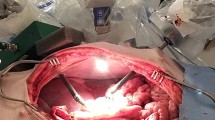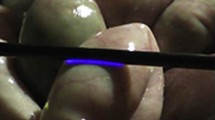Abstract
Background
Insulation defects are observed in 3–39 % of laparoscopic instruments. Electrosurgical injuries due to insulation defects or capacitive coupling remain an issue in laparoscopic surgery with a prevalence of 0.6–5 per thousand cases. Shielded instruments with active electrode monitoring (AEM) have been postulated to prevent these injuries. The benefit of these instruments has not been quantified. Most bowel injuries are unrecognized intra-operatively. Injury is revealed only after the patient exhibits peritonitis symptoms and surgical intervention to repair the bowel is required. These injuries may result in devastating and costly complications or mortality. The extent of bowel injury possible with commonly used generator settings and associated energy output has never been histologically defined. Our objectives in this experimental study were: quantify and compare the energy released through insulation defects or capacitive coupling with standard unshielded monopolar versus shielded instruments with (AEM), determine energy required to cause a visible burn, and relate the histological burn depth to a given amount of energy.
Methods
Ex vivo porcine jejunum was used for tissue testing. An oscilloscope measured energy output from three common electrosurgical generators at recommended power settings with standard or AEM instruments with insulation defects and in capacitive coupling scenarios. Presence of a visible burn was noted, and depth of tissue damage for a given amount of energy was measured histologically.
Results
All samples that received ≥3.8 J of energy had visible burns. As little as 10 J caused full wall thickness burns. 3.8 J was exceeded at the 30- and 50-W power settings in every experimental scenario using standard monopolar instruments; AEM instruments never approached this much energy.
Conclusions
Serious burn injury results from small amounts of energy leaked from standard instruments. AEM instruments appeared protective and did not leak sufficient energy to cause burn injuries to the bowel.





Similar content being viewed by others
References
Abu-Rafea B, Vilos GA, Al-Obeed O, Al Sheikh A, Vilos AG, Al-Mandeel H (2011) Monopolar electrosurgery through single-port laparoscopy: a potential hidden hazard for bowel burns. J Minim Invasive Gynecol 18:734–740
Hulka JF, Levy BS, Parker WH, Phillips JM (1997) Laparoscopic-assisted vaginal hysterectomy: American Association of Gynecologic Laparoscopists’ 1995 membership survey. J Am Assoc Gynecol Laparosc 4:167–171
Nduka CC, Super PA, Monson JR, Darzi AW (1994) Cause and prevention of electrosurgical injuries in laparoscopy. J Am Coll Surg 179:161–170
Voyles CR, Tucker RD (1992) Education and engineering solutions for potential problems with laparoscopic monopolar electrosurgery. Am J Surg 164:57–62
Montero PN, Robinson TN, Weaver JS, Stiegmann GV (2010) Insulation failure in laparoscopic instruments. Surg Endosc 24:62–65
Jones EL, Dunn CL, Townsend NT, Jones TS, Bruce Dunne J, Montero PN, Govekar HR, Stiegmann GV, Robinson TN (2013) Blend mode reduces unintended thermal injury by laparoscopic monopolar instruments: a randomized controlled trial. Surg Endosc 27:4016–4020
Robinson TN, Pavlovsky KR, Looney H, Stiegmann GV, McGreevy FT (2010) Surgeon-controlled factors that reduce monopolar electrosurgery capacitive coupling during laparoscopy. Surg Laparosc Endosc Percutan Tech 20:317–320
Mäkinen J, Brummer T, Jalkanen J, Heikkinen AM, Fraser J, Tomás E, Härkki P, Sjöberg J (2013) Ten years of progress-improved hysterectomy outcomes in Finland 1996–2006: a longitudinal observation study. BMJ Open. doi:10.1136/bmjopen-2013-0031693(10)e003169
Bishoff JT, Allaf ME, Kirkels W, Moore RG, Kavoussi LR, Schroder F (1999) Laparoscopic bowel injury: incidence and clinical presentation. J Urol 161:887–890
Yazdani A, Krause H (2007) Laparoscopic instrument insulation failure: the hidden hazard. J Minim Invasive Gynecol 14:228–232
Espada M, Munoz R, Noble BN, Magrina JF (2011) Insulation failure in robotic and laparoscopic instrumentation: a prospective evaluation. Am J Obstet Gynecol 205(121):e1–e5
Pierce J (1986) Electrosurgery Wiley medical. Division of John Wiley & Sons, Inc., New York
Overbey DM, Townsend NT, Chapman BC, Bennett DT, Foley LS, Rau AS, Yi JA, Jones EL, Stiegmann GV, Robinson TN (2015) Surgical energy-based device injuries and fatalities reported to the food and drug administration. J Am Coll Surg 221:197–205
Calabrese E, Zorzi F, Onali S, Stasi E, Fiori R, Prencipe S, Bella A, Petruzziello C, Condino G, Lolli E, Simonetti G, Biancone L, Pallone F (2013) Accuracy of small-intestine contrast ultrasonography, compared with computed tomography enteroclysis, in characterizing lesions in patients with Crohn’s disease. Clin Gastroenterol Hepatol 11:950–955
Fraquelli M, Sarno A, Girelli C, Laudi C, Buscarini E, Villa C, Robotti D, Porta P, Cammarota T, Ercole E, Rigazio C, Senore C, Pera A, Malacrida V, Gallo C, Maconi G (2008) Reproducibility of bowel ultrasonography in the evaluation of Crohn’s disease. Dig Liver Dis 40:860–866
Emergency care Research Institute (2005) Safety technologies for laparoscopic monopolar electrosurgery; devices for managing burn risks. Health Devices 34:259–272
Funding
This work was funded from an unrestricted Grant from Encision, Inc.
Author information
Authors and Affiliations
Corresponding author
Ethics declarations
Disclosures
Kimberly E. Martin, Camille M. Moore, Robert Tucker, Pascal Fuchshuber, and Thomas Robinson have no conflicts of interest or financial ties to disclose.
Rights and permissions
About this article
Cite this article
Martin, K.E., Moore, C.M., Tucker, R. et al. Quantifying inadvertent thermal bowel injury from the monopolar instrument. Surg Endosc 30, 4776–4784 (2016). https://doi.org/10.1007/s00464-016-4807-z
Received:
Accepted:
Published:
Issue Date:
DOI: https://doi.org/10.1007/s00464-016-4807-z




